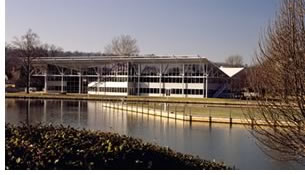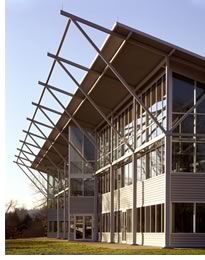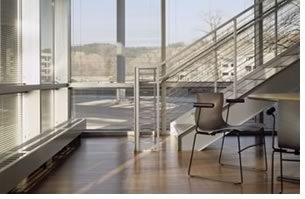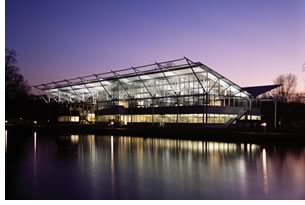

09/2005
HOK’s new Winrock HQ earns Gold LEED™
 One
nonprofit organization has embraced green design as a means to underscore
its mission. Founded by Winthrop Rockefeller, Winrock International “works
with people around the world to increase economic opportunity, sustain
natural resources, and protect the environment.” The new Winrock
International headquarters building in Little Rock, designed by the New
York City office of HOK, has just become the first office building and
only the second building in the state of Arkansas to receive the LEED™-Gold
rating. Winrock’s headquarters is one of 70 buildings in the U.S.
to attain Gold rating.
One
nonprofit organization has embraced green design as a means to underscore
its mission. Founded by Winthrop Rockefeller, Winrock International “works
with people around the world to increase economic opportunity, sustain
natural resources, and protect the environment.” The new Winrock
International headquarters building in Little Rock, designed by the New
York City office of HOK, has just become the first office building and
only the second building in the state of Arkansas to receive the LEED™-Gold
rating. Winrock’s headquarters is one of 70 buildings in the U.S.
to attain Gold rating.
 Established in 1985, Winrock works with its partners to link individuals
and communities with new ideas and technologies, advocating innovation
in agriculture, natural resource management, alternative energy, and
leadership development. According to Rhoda Chan, the LEED-accredited
project architect, Winrock instigated the LEED process with HOK. “Yes,
they approached us about LEED certification,” she says. “We
were contracted for Silver certification, but ended up receiving Gold.”
Established in 1985, Winrock works with its partners to link individuals
and communities with new ideas and technologies, advocating innovation
in agriculture, natural resource management, alternative energy, and
leadership development. According to Rhoda Chan, the LEED-accredited
project architect, Winrock instigated the LEED process with HOK. “Yes,
they approached us about LEED certification,” she says. “We
were contracted for Silver certification, but ended up receiving Gold.”
 Principal
Kenneth Drucker, AIA, reports, “The Winrock International
organization has been a great client. Led by Frank Tugwell, president
[and CEO,] and the very active Trustee Bronson Van Wyck, we worked collaboratively
on coming up with a design that reflected Winrock’s mission to
teach sustainability and self-sufficiency throughout the developing world
. . . Winrock has been a critical partner in defining both the design
and sustainable aspirations for the project. The client asked that we
create a ‘replicable’ design that could be seen as a new
precedent for innovation in Arkansas. The idea was to create a design
that could be linked back to Arkansas’ agrarian past while looking
forward to show that sustainability could be affordable in the region.” The
resultant design is a “modern dogtrot”—a structure
that consists of two buildings that flank a central passageway, open
at the ends and beneath a common roof. The roots of the design reflect
farmers’ vernacular in dealing with Arkansas’ hot, humid
summers: as the dogtrot breezeway draws wind through the passageway,
it redistributes air, cooling the buildings.
Principal
Kenneth Drucker, AIA, reports, “The Winrock International
organization has been a great client. Led by Frank Tugwell, president
[and CEO,] and the very active Trustee Bronson Van Wyck, we worked collaboratively
on coming up with a design that reflected Winrock’s mission to
teach sustainability and self-sufficiency throughout the developing world
. . . Winrock has been a critical partner in defining both the design
and sustainable aspirations for the project. The client asked that we
create a ‘replicable’ design that could be seen as a new
precedent for innovation in Arkansas. The idea was to create a design
that could be linked back to Arkansas’ agrarian past while looking
forward to show that sustainability could be affordable in the region.” The
resultant design is a “modern dogtrot”—a structure
that consists of two buildings that flank a central passageway, open
at the ends and beneath a common roof. The roots of the design reflect
farmers’ vernacular in dealing with Arkansas’ hot, humid
summers: as the dogtrot breezeway draws wind through the passageway,
it redistributes air, cooling the buildings.
Tugwell views the project as proof positive that economics and environmental responsibility are complementary, not contradictory. “Our building shows that it doesn’t take a lot of money, just good planning and common sense to build green,” he says. “We’ve strived to build a structure that is good for people and the environment, and we’ve achieved both goals. Most importantly, the building illustrates our commitment to Winrock’s mission—increase economic opportunity, sustain natural resources, and protect the environment.”
 The
24,000-square-foot facility houses 74 employees and cost just over $4
million. It has a broad gull-wing roof and glass and aluminum curtain
wall. The roof shields the inhabitants from excessive sunlight and drains
rainwater into a cistern that will provide water for grounds irrigation.
Pervious paving prevents excessive runoff, and hearty, indigenous plants
further reduce the amount of potable water required to keep the grounds
green. The abundant natural lighting reduces energy costs, as does the
under-floor air supply system that conditions only occupied spaces. The
corrugated steel roof is highly emissive, reducing heat absorption to
the interior and, therefore, cooling requirements in the summer. The
low-VOC carpets, paints, sealants, glues, and furnishings throughout
had time to off-gas prior to occupancy. In addition, the building contains
25 percent post-consumer/industrial recycled materials, and the builder
recycled more than 75 percent of the construction waste.
The
24,000-square-foot facility houses 74 employees and cost just over $4
million. It has a broad gull-wing roof and glass and aluminum curtain
wall. The roof shields the inhabitants from excessive sunlight and drains
rainwater into a cistern that will provide water for grounds irrigation.
Pervious paving prevents excessive runoff, and hearty, indigenous plants
further reduce the amount of potable water required to keep the grounds
green. The abundant natural lighting reduces energy costs, as does the
under-floor air supply system that conditions only occupied spaces. The
corrugated steel roof is highly emissive, reducing heat absorption to
the interior and, therefore, cooling requirements in the summer. The
low-VOC carpets, paints, sealants, glues, and furnishings throughout
had time to off-gas prior to occupancy. In addition, the building contains
25 percent post-consumer/industrial recycled materials, and the builder
recycled more than 75 percent of the construction waste.
 The building also has minimal dependence on traditional energy sources.
Wind power from an outside source will provide 100 percent of the power
for the first two years, at which time the contract may be extended.
To reduce transportation-related energy usage, Winrock is providing vanpooling
for long distance commuters and two Toyota Prius hybrids for in-town
use.
The building also has minimal dependence on traditional energy sources.
Wind power from an outside source will provide 100 percent of the power
for the first two years, at which time the contract may be extended.
To reduce transportation-related energy usage, Winrock is providing vanpooling
for long distance commuters and two Toyota Prius hybrids for in-town
use.
“The team worked extremely well together,” notes Drucker. “All had the same goals of reaching for a Gold LEED certification while staying within the financial constraints of the project. In the end, we were able to achieve more LEED points than we realized, and we held on to the major design goals of the project.”
Copyright 2005 The American Institute of Architects.
All rights reserved. Home Page ![]()
![]()
 |
||
Photos by Craig Dugan/Hedrich Blessing
|
||